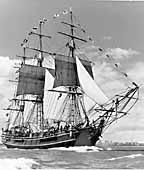
Stockwell Day website statistics, first four days
Source: http://www.stockwellday.com/xxwebstats/index_01_b.htm
Chapter 55
2000 March 20-31
Index with links to the other chapters
 An interview with president Norman Futoransky that appeared in Fall River's Herald News February 6th did confirm the ship needs about $1,000,000 in repairs in order to receive Coast Guard certification as a sail training vessel. That's the foundation's current plan — to certify the ship so she would be able to carry up to 155 people, crew included, on overnight excursions, he said.
An interview with president Norman Futoransky that appeared in Fall River's Herald News February 6th did confirm the ship needs about $1,000,000 in repairs in order to receive Coast Guard certification as a sail training vessel. That's the foundation's current plan — to certify the ship so she would be able to carry up to 155 people, crew included, on overnight excursions, he said.
Appendix to CRTC Decision 2000-83
Licensee: CHUM Limited
Associated AM or Proposed DRU Effective isotropic
FM station & frequency radiated power
Application number (watts)
CKWW 199912712 1484.208 MHz 4,369
CIMX-FM 199912697 1484.208 MHz 4,369
CKLW 199912671 1484.208 MHz 4,369
CIDR-FM 199912738 1484.208 MHz 4,369
|
CHUM Limited — the "applicant" above — owns and operates several broadcasting stations in Nova Scotia, including — Halifax radio stations CJCH and CIOO-FM — ATV (Atlantic Television System), consisting of CJCH-TV Halifax CJCB-TV Sydney CKCW-TV Moncton CKLT-TV Saint John — ASN (Atlantic Satellite Network) a satellite-to-cable broadcaster Source: CRTC Decision 95-417, 7 July 1995 http://www.crtc.gc.ca/eng/bcasting/decision/1995/d95417.txt |
|
ICS Comment (written 5:00pm 29 March 2000)
As of March 29th, this website had remarkably little content. The entry page at http://www.pm4pm.com/index.html contained the press release announcing the candidacy, several long lists of names associated with the National Campaign Committee, and a link to a webpage http://www.pm4pm.com/support.html asking for contributions. That's all. There was no platform, no biography, no question-and-answer section, no FAQ, no background information, no information of any kind about who Mr. Manning is or what his plan for Canada's future might be. Remarkably, there were no links to any other websites, not even to a site for the Canadian Alliance. There was no information about how the leadership would be decided, no description of the voting procedure or dates, no mention of who is in charge of these important details. Looking at this site, I got the strong impression that it was designed by someone with not the least grasp of how the Internet works or how it might be used to establish communication between a political leader and the people he wants to lead. There was no hint that Mr. Manning or any of his support staff has any comprehension of the current state or the future implications or possibilities of modern electronic information and communications technology as applied to politics or economic development or education or anything else. My impression was that the sole motivation for this website is the current notion that having a website is fashionable. They knew months in advance that this leadership campaign was coming. They had months to make plans and to research how other political leaders or wannabes have used the Internet for political purposes. They had months to prepare, and this is the best they can do? Suppose someone should ask: What would you do if a political leader called you tomorrow and asked you to be a member of his/her website design team? My answer is: The first thing I would do would be to get some idea of what resources the Internet currently offers, to provide ideas and inspiration and hints about how a well-designed political website should be put together. At 5:15am, March 29th, I went to the Google search engine and did a search on two keywords: And he wants us to choose him to lead us into the future? |
|
ICS Comment (written 3:30am 22 April 2000)
On 22 April, I looked again at Mr. Manning's website. There have been significant improvements in the last three weeks, but the website is still a very long way from demonstrating that Mr. Manning or his senior staff have any real grasp of how the Internet can be used to further a political cause. There is still a remarkably limited offering in that site. At this time, Google (the best search engine now available) reports 6,823 webpages containing the phrase "Preston Manning". This search turned up many sites that seem to me should be linked from Mr. Manning's website. For example,
Then I looked in the Hansard Index, the key to information about what is said by Members of Parliament in the House of Commons during the 36th Parliament, 2nd Session (from 12 October 1999 to the present). I went to the Hansard Index at http://www.parl.gc.ca/36/2/parlbus/chambus/house/debates/indexe/homepage.html and brought up the Index entry for Internet/information highway at http://www.parl.gc.ca/36/2/parlbus/chambus/house/debates/indexe/i-36-2_1-e.html This is a very extensive list, containing about 140 entries under Internet/information highway. It seems to me Mr. Manning's website should provide a collection of links to Hansard reports of statements or questions by Mr. Manning on an assortment of topics, including the Internet and related topics. This is an obvious opportunity overlooked by the website designers. |

|
Wayback Machine http://web.archive.org/index.html "Use the Wayback Machine to view web sites from the past." History of Nova Scotia, Chapter 55 The Wayback Machine has copies of this webpage from the early days: Archived: 2001 July 20 http://web.archive.org/web/20010720125619/http://epe.lac-bac.gc.ca/100/205/300/nova_scotias_electronic_attic/07-04-09/www.littletechshoppe.com/ns1625nshist55.html |
Index with links to the other chapters
![]()
W3C HTML Validation Service
http://validator.w3.org/
![]()
W3C CSS Validation Service
http://jigsaw.w3.org/css-validator/